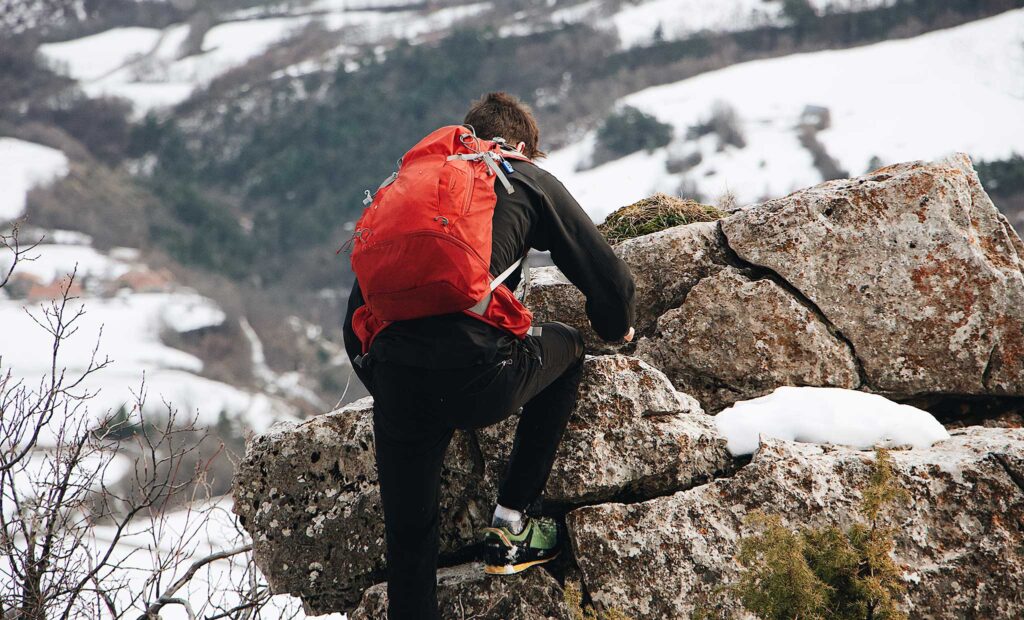Just heard about scrambling and fancy giving it a go? Well, here’s everything you need to know about scrambling, including exactly what it is, how scrambles are graded in difficulty and a few tips to get you started.
What Is Rock Scrambling?
Think of scrambling, also sometimes called rock scrambling, as an outdoor activity that falls somewhere between hiking and climbing. Essentially, as a hiking trail gets steeper and more exposed, you’ll find yourself using your hands as well as your feet to get up the mountain, which is known as scrambling. As soon as you find yourself on vertical terrain and need of a rope, you’re climbing.
In other words, scrambling can be considered a form of extreme hiking that requires the use of you hands for balance. It’s the perfect activity for hikers looking for a new challenge but don’t quite fancy something quite as extreme as climbing.

How Hard Is Scrambling?
Well, it very much depends on your own skills. If you’ve had very little experience with any form of extreme hiking, you may find it to be quite a challenge. However, if you’ve ever experienced even a little bit of bouldering or climbing, you may find it to be well within your comfort zone.
In the UK, scrambling routes are graded on a scale of 1 to 3, with a Grade 1 scramble being the easiest and Grade 3 scramble being the most difficult. Grade 1 scrambles are typically easy to follow and do not require any technical skills. Grade 2 scrambles are a bit more challenging and may require the use of hands and feet to climb over rocks and boulders. Grade 3 scrambles are the most difficult and may even require the use of ropes and other climbing gear.
Here is a more detailed explanation of each of the three scrambling grades:
Grade 1 Scrambling
Grade 1 scrambles are the easiest and are typically easy to follow. You’ll likely need to use your hands across parts of the scramble, though not all the time. When you do need them, it should be pretty obvious where you place need to place your hands and you shouldn’t need any technical climbing skills. You’ll generally find that Grade 1 include ways to avoid certain parts of the route and may, in some cases, offer an escape route to avoid the rest of the route altogether if needed.
A Grade 1 scramble is a fantastic option for beginners and experienced scramblers alike. Some of the more popular Grade 1 scrambles include:
- Striding Edge on Helvellyn, England
- Crib Goch on Snowdon, Wales
- Jack’s Rake on Pavey Ark, England
- Tryfan North Ridge, Wales
- CMD Arête on Ben Nevis, Scotland
Grade 2 Scrambling
Grade 2 scrambles are a little more challenging and will likely require the use of you hands along most if not all of the route. The scramble will be a bit more committing as there will rarely be ways to avoid sections of the route or turn back, and even following the route itself can be a little more difficult. They may also involve some exposure, but the exposure is typically not too daunting.
Grade 2 scrambles are a good option for experienced scramblers who are looking for a bit more of a challenge. Some popular Grade 2 scrambles include:
- Aonach Eagach in Glen Coe, Scotland
- Pinnacle Ridge in Snowdonia, Wales
- Broad Buttress on Buachaille Etive Mor, Scotland
- Bryant’s Gully at Glyder Fawr, Wales
- Climber’s Traverse & Sphinx Ridge on Great Gable, England
Grade 3 Scrambling
Grade 3 scrambles are the most difficult. You’ll most definitely need your hands along most of the route and may even find yourself performing some technical climbing moves. In fact, you’ll most likely encounter difficult scrambling exposed sections of the route and will probably need the use of a rope for extra safety and may even need other climbing gear to help. At this point, the line between scrambling and climbing becomes rather blurry.
Grade 3 scrambles should only be attempted by experienced scramblers who have the necessary skills and equipment. Some popular Grade 3 scrambles include:
- Pinnacle Ridge on St. Sunday Crag, England
- Dolmen Ridge on Glyder Fach, Wales
- Idwal Staircase & Continuation at Idwal Slabs, Wales
It is important to note that these are just general descriptions of the three scrambling grades. The difficulty of a scramble can vary depending on the specific route and, most importantly, the weather conditions. It is always important to research the route in-depth before attempting a new scramble.
Scrambling Equipment
While there isn’t really any such a think as scrambling-specific gear, there are definitely a few pieces of equipment that will help you stay safe and comfortable while scrambling:
- Hiking Boots – a sturdy pair of hiking boots that go above the ankle will give you a stable footing and make scrambling so much more enjoyable.
- Hiking Trousers or Leggings – clothing that covers your arms and legs will help when your find yourself “hugging the rock”.
- Gloves – can be particularly helpful in wet conditions, which in the UK is most of the time!
Once you start taking on more difficult Grade 3 scrambles, you may want to look into taking a rope with you, though the point of scrambling is that a rope isn’t essential.
Scrambling Tips for Beginners
If you’re new to scrambling, here’s a few tips that will help you get started:
- Always scramble with someone else and let someone know where you’re going.
- Start with easier Grade 1 scrambles and work your way up.
- Maintain three points of contact with the rock at all times.
- Focus on placing your feet before your hands. After all, your hands should only really be needed for balance.
- If at any point you feel uncomfortable or unsafe, turn back.
Scrambling FAQs
Scrambling lies somewhere between hiking and bouldering. Think of scrambling as hiking that requires the use of your hands mainly for balance, while bouldering often requires being able to pull your weight up with your hands.
Yes, hiking boots are probably the best footware for scrambling. Stiff hiking boots that go above the ankle will give you plenty of ankle stability and help you keep your balance when using slightly more awkward footholds.
No, gloves aren’t essential for scrambling but they can be helpful, particularly in wet conditions. Gloves with a tacky surface can help you get a better grip of the rock, though ultimately it’s down to your personal preference.
Most scrambling does not require a rope. However, you should take a rope with you as it can be particularly helpful on more difficult pitches on Grade 3 scrambles or simply when scrambling with a less confident adventurer.
Yes, rock scrambling in the USA is graded Class 1-5, with Class 1 being the easiest and Class 5 being the hardest.
And that’s it. While it isn’t everything you need to know about scrambling, it’s certainly enough to get you started on your scrambling adventure. Break a leg!




